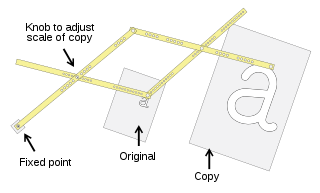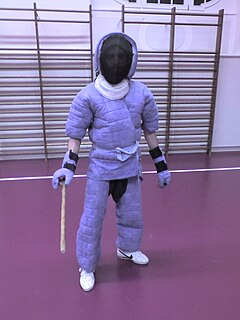
A pointing device is a human interface device that allows a user to input spatial data to a computer. CAD systems and graphical user interfaces (GUI) allow the user to control and provide data to the computer using physical gestures by moving a hand-held mouse or similar device across the surface of the physical desktop and activating switches on the mouse. Movements of the pointing device are echoed on the screen by movements of the pointer and other visual changes. Common gestures are point and click and drag and drop.

A pantograph is a mechanical linkage connected in a manner based on parallelograms so that the movement of one pen, in tracing an image, produces identical movements in a second pen. If a line drawing is traced by the first point, an identical, enlarged, or miniaturized copy will be drawn by a pen fixed to the other. Using the same principle, different kinds of pantographs are used for other forms of duplication in areas such as sculpture, minting, engraving, and milling.

A fishing rod is a long, thin rod used by anglers to catch fish by manipulating a line ending in a hook. At its most basic form, a fishing rod is a straight rigid stick/pole with a line attached to one end ; however, modern rods are usually elastic and generally have the line stored in a reel mounted at the rod handle, which is hand-cranked and controls the line retrieval, as well as numerous line-restricting rings that distribute bending stress along the rod and help dampening down/prevent line whipping and entanglement. To better entice fish, baits or lures are dressed onto the one or more hooks attached to the line, and a bite indicator is used, some of which might be incorporated as part of the rod itself.

A staff of office is a staff, the carrying of which often denotes an official's position, a social rank or a degree of social prestige.

A pointing stick is a small analog stick used as a pointing device typically mounted centrally in a computer keyboard. Like other pointing devices such as mice, touchpads or trackballs, operating system software translates manipulation of the device into movements of the pointer or cursor on the monitor. Unlike other pointing devices, it reacts to sustained force or strain rather than to gross movement, so it is called an "isometric" pointing device. IBM introduced it commercially in 1992 on its laptops under the name "TrackPoint", patented in 1997.

A touchpad or trackpad is a pointing device featuring a tactile sensor, a specialized surface that can translate the motion and position of a user's fingers to a relative position on the operating system that is made output to the screen. Touchpads are a common feature of laptop computers as opposed to using a mouse on a desktop, and are also used as a substitute for a mouse where desk space is scarce. Because they vary in size, they can also be found on personal digital assistants (PDAs) and some portable media players. Wireless touchpads are also available as detached accessories.

Caning is a form of corporal punishment consisting of a number of hits with a single cane usually made of rattan, generally applied to the offender's bare or clothed buttocks or hands. Caning on the knuckles or shoulders is much less common. Caning can also be applied to the soles of the feet. The size and flexibility of the cane and the mode of application, as well as the number of the strokes, vary greatly—from a couple of light strokes with a small cane across the seat of a junior schoolboy's trousers, to up to 24 very hard, wounding cuts on the bare buttocks with a large, heavy, soaked rattan as a judicial punishment in some Southeast Asian countries.

Singlestick is a martial art that uses a wooden stick as its weapon. It began as a way of training soldiers in the use of backswords. Canne de combat, a French form of stick fighting, is similar to singlestick play, which also includes a self-defense variant with a walking stick.

A laser pointer or laser pen is a small handheld device with a power source and a laser diode emitting a very narrow coherent low-powered laser beam of visible light, intended to be used to highlight something of interest by illuminating it with a small bright spot of colored light.
In computer user interfaces, a cursor is an indicator used to show the current position for user interaction on a computer monitor or other display device that will respond to input from a text input or pointing device. The mouse cursor is also called a pointer, owing to its resemblance in usage to a pointing stick.

A three-point field goal is a field goal in a basketball game made from beyond the three-point line, a designated arc surrounding the basket. A successful attempt is worth three points, in contrast to the two points awarded for field goals made within the three-point line and the one point for each made free throw.
The rute, also known as a multi-rod, is a beater for drums. Commercially made rutes are usually made of a bundle of thin birch dowels or thin canes attached to a drum stick handle. These often have a movable band to adjust how tightly the dowels are bound toward the tip. A rute may also be made of a bundle of twigs attached to a drum stick handle. These types of rutes are used for a variety of effects with various musical ensembles. A rute may also be a cylindrical bunch of pieces of cane or twigs, bound at one end, like a small besom without a handle. The rute is used to play on the head of the bass drum. Rute are also constructed from a solid rod thinly split partway down.

Kubotan is a genericized trademark for a self-defense keychain weapon developed by Sōke Takayuki Kubota in the late 1960s. It is typically no more than 5.5 inches long and about half an inch in diameter, slightly thicker or the same size as a marker pen. The material is usually a hard high-impact plastic such as Lexan. The body of the Kubotan is lined with six round grooves with a screw eye or swivel and split ring attachment at one end for keys.

A bamboo fly rod or a split cane rod is a fly fishing rod that is made from bamboo. The British generally use the term "split cane." In the U.S., most use the term "bamboo." The "heyday" of bamboo fly rod production and use was an approximately 75-year period from the 1870s to the 1950s when fiberglass became the predominant material for fly rods. Nevertheless, bamboo fly rods made from skilled makers continue to be 'state-of-the-art' in performance and are cherished and revered by their owners.

A cane gun is a walking cane with a hidden gun built into it. Cane guns are sometimes confused with so-called "poacher's guns".

Canne de combat is a French combat sport. As weapon, it uses a canne or cane designed for fighting. Canne de combat was standardized in the 1970s for sporting competition by Maurice Sarry. The canne is very light, made of chestnut wood and slightly tapered. A padded suit and a fencing mask are worn for protection.

Tenkara fishing is a type of simple rod angling traditionally practiced in Japan. Primarily used for mountain stream trout fishing, tenkara is still a fairly rare method even among freshwater anglers in Japan, and was largely unknown outside Japan until 2009, when the company Tenkara USA, founded by Daniel Galhardo, introduced and popularized tenkara outside Japan.

In computing, an input device is a piece of equipment used to provide data and control signals to an information processing system, such as a computer or information appliance. Examples of input devices include keyboards, mouse, scanners, cameras, joysticks, and microphones.

A walking stick or walking cane is a device used primarily to aid walking, provide postural stability or support, or assist in maintaining a good posture. Some designs also serve as a fashion accessory, or are used for self-defense.

















